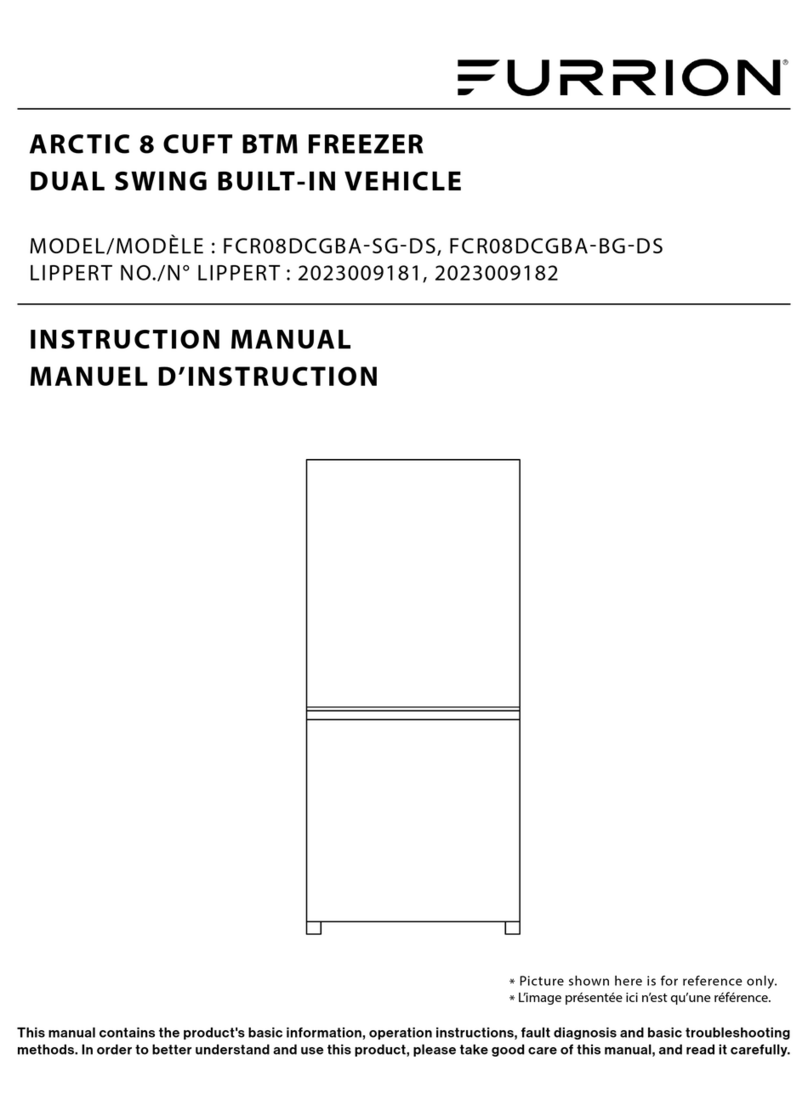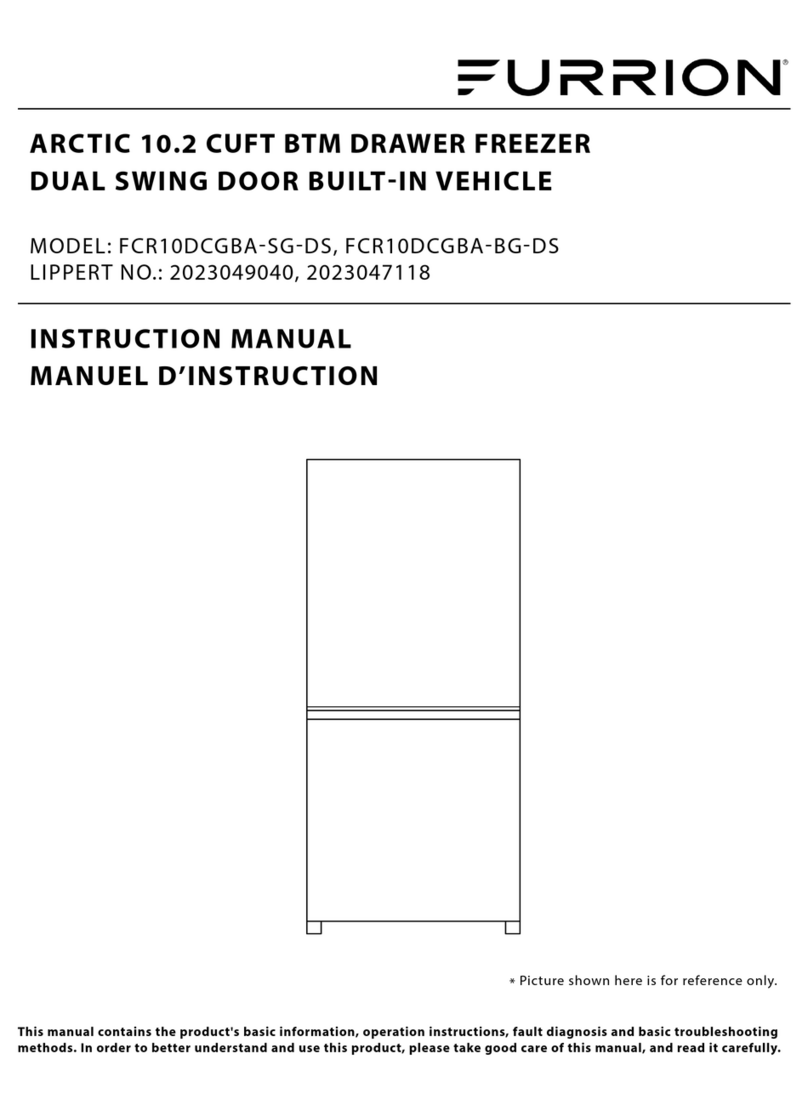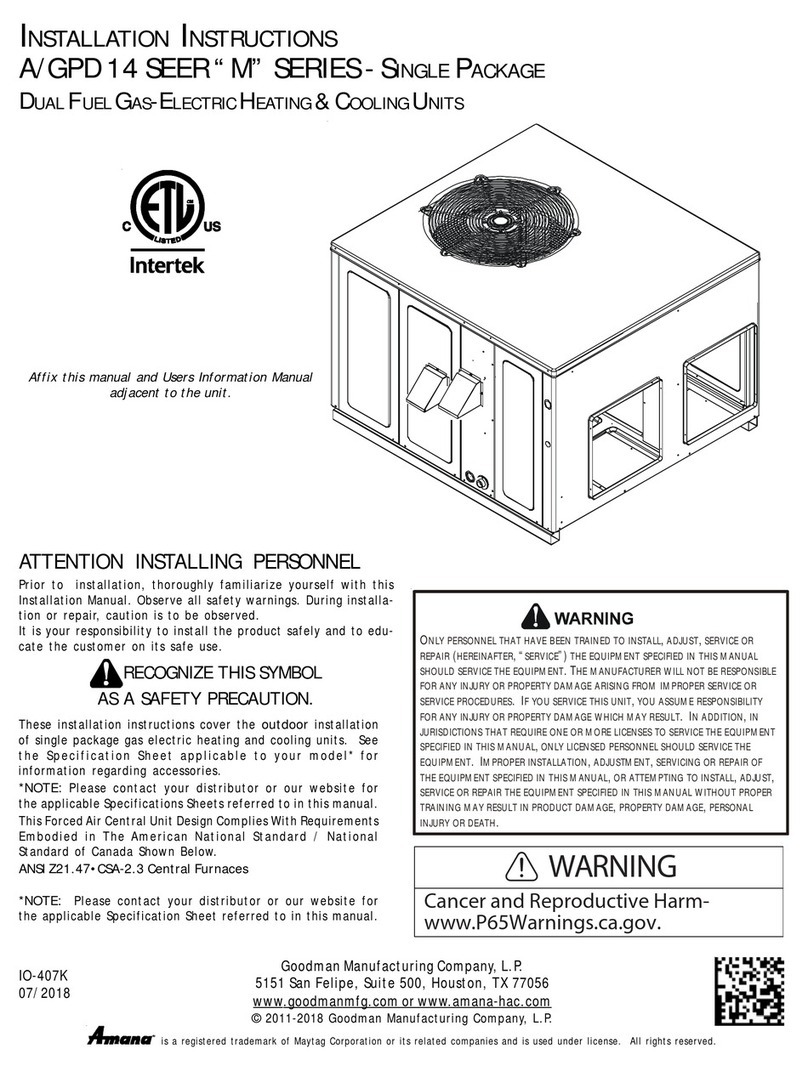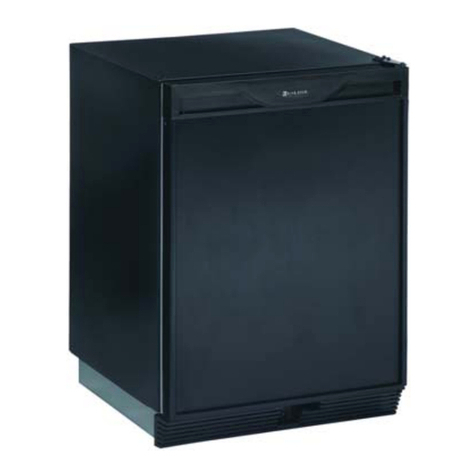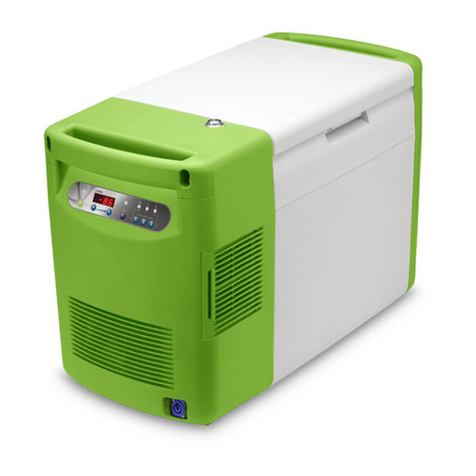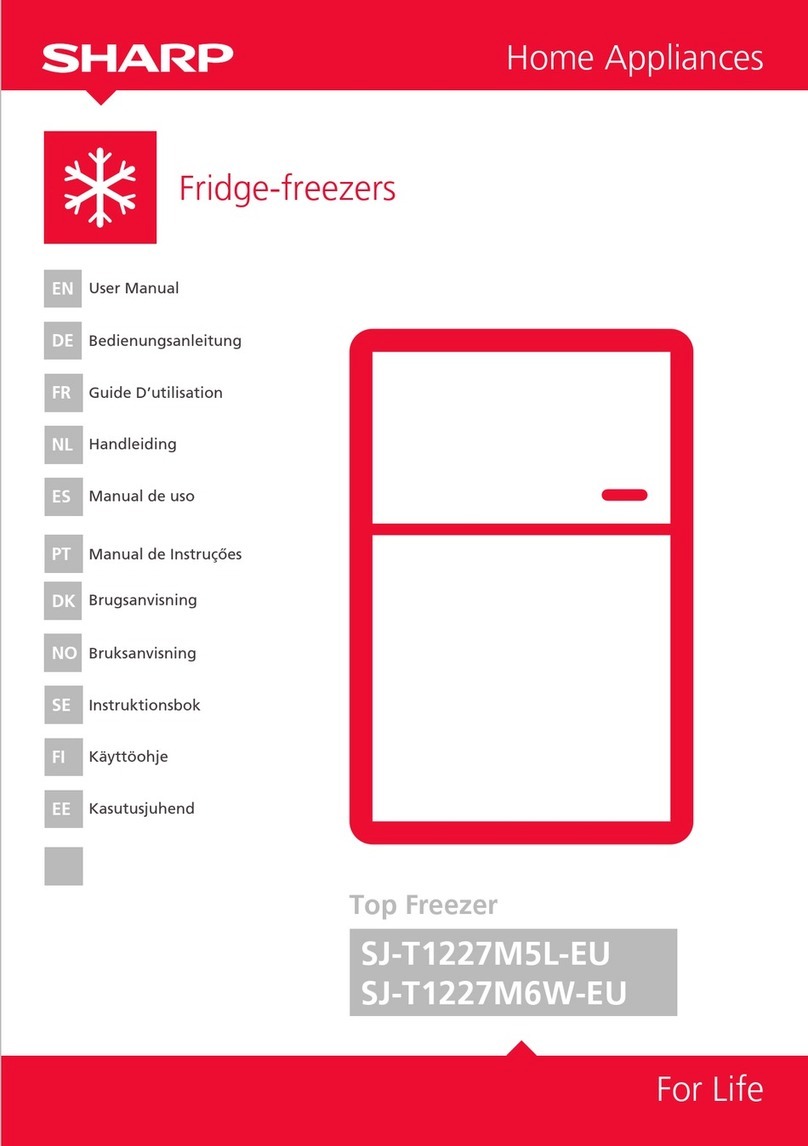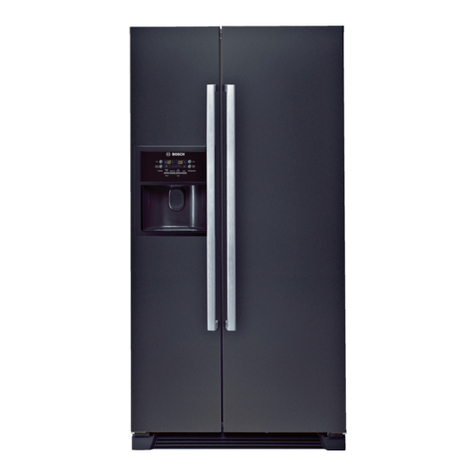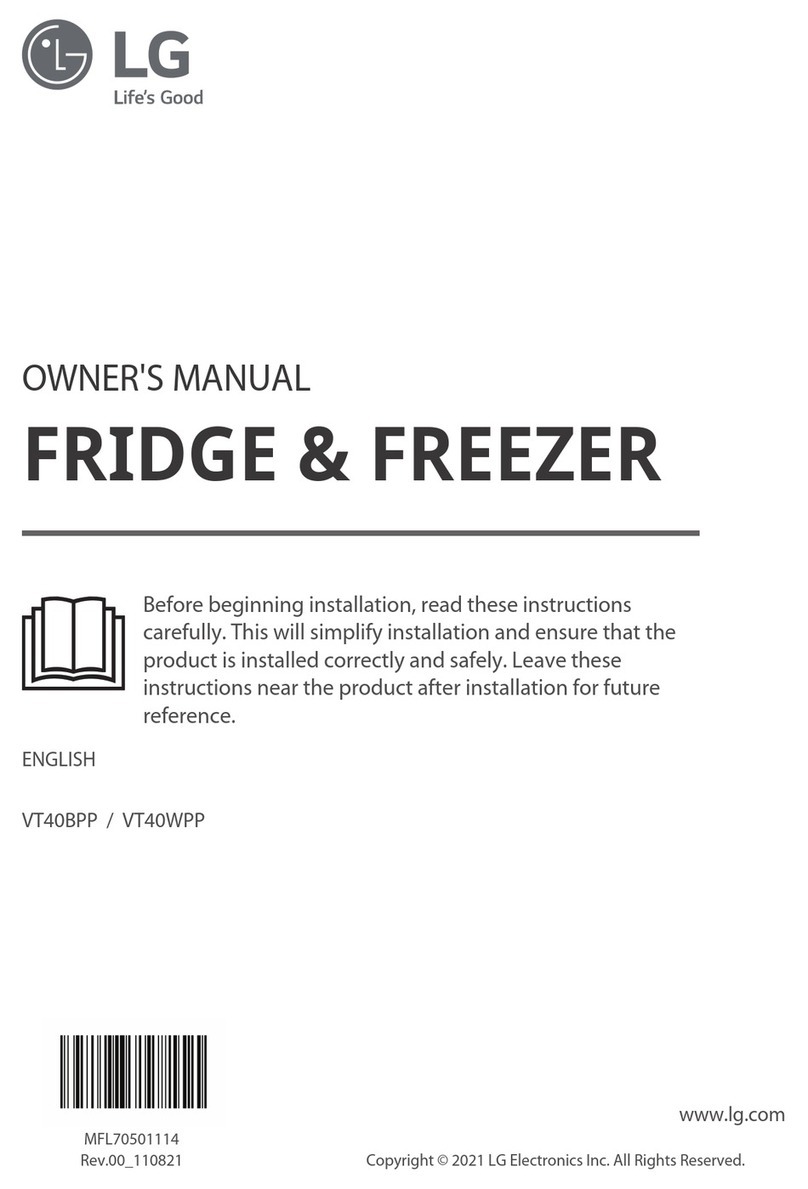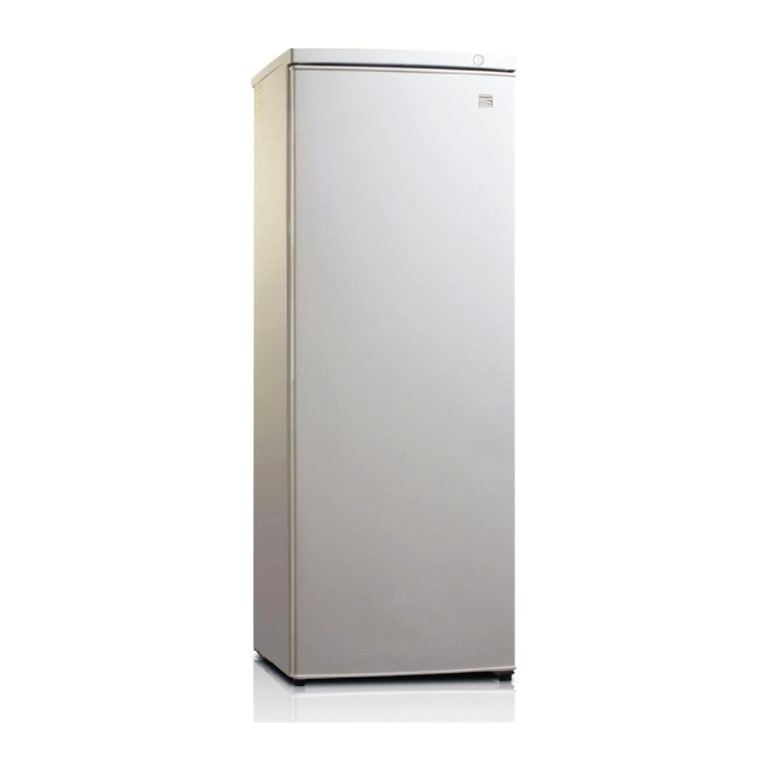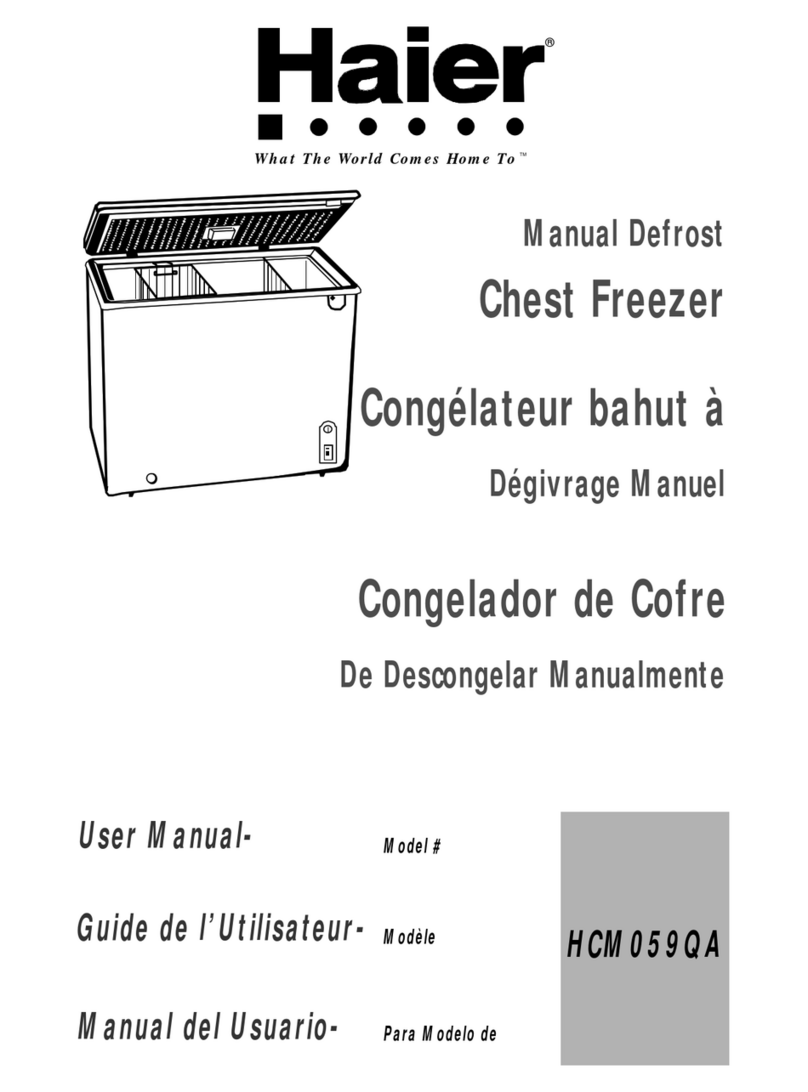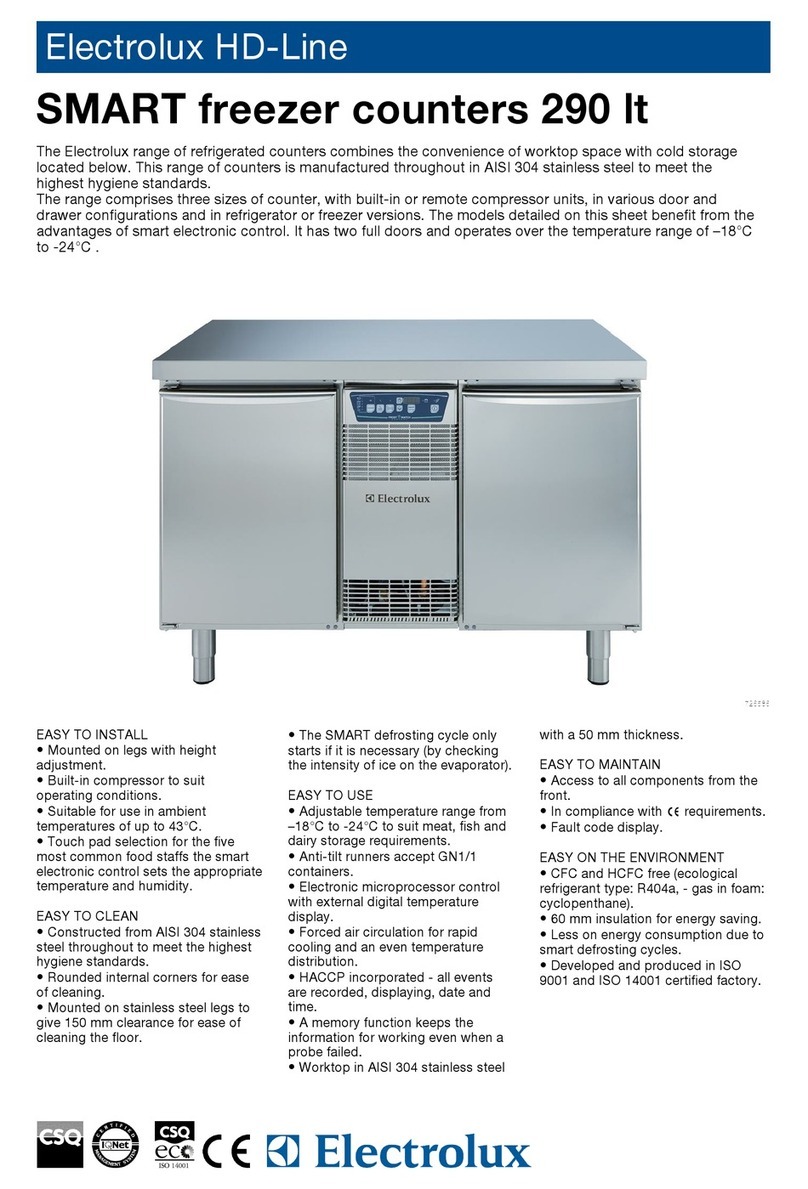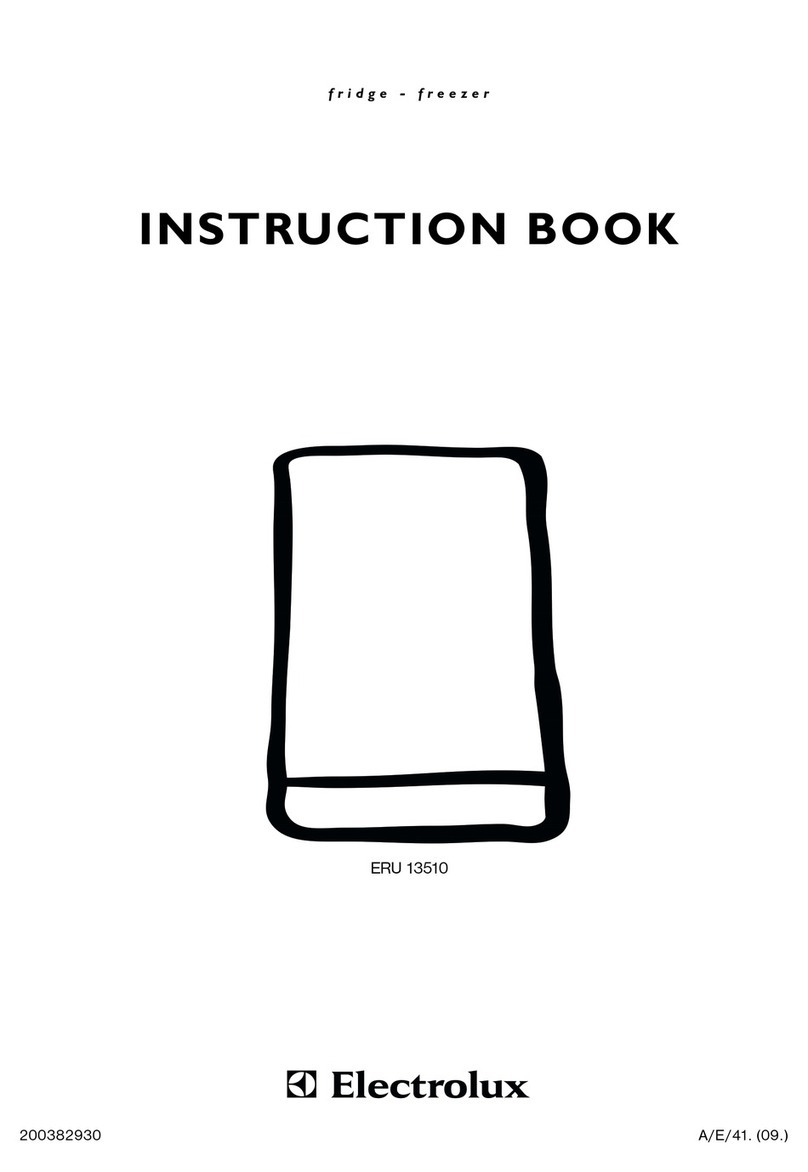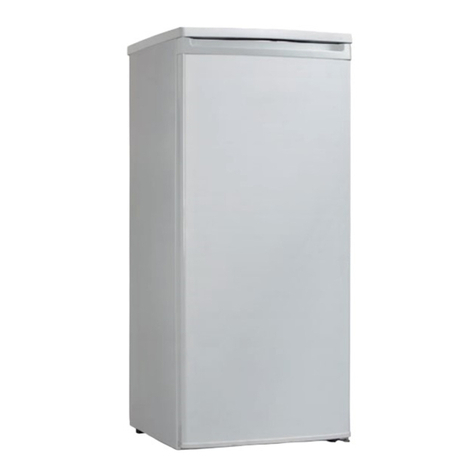Furrion FCR06DCGTA-SG-DS User manual

FURRION ARCTIC 6.2 CUFT BTM FREEZER
DUAL SWING BUILT-IN VEHICLE
FURRION ARCTIC 6.2 CONGÉLATEUR BTM PI CUBE
VÉHICULE INTÉGRÉ À DEUX BATTANTS
MODEL/MODÈLE: FCR06DCGTA-SG-DS, FCR06DCGTA-BG-DS
LIPPERT NO./N° LIPPERT : 2023017224, 2023005699
INSTRUCTION MANUAL
MANUEL D’INSTRUCTION
Dear user, this manual contains the product's basic information, including operation, diagrams and basic
troubleshooting.
Cher utilisateur, ce manuel contient les renseignements de base sur le produit, notamment le fonctionnement, les
diagrammes et les procédures de dépannage de base.

English
CCD-0007756 Rev: 06-05-23 - 1 -
Thank you and congratulations on purchasing this Furrion product. Before operating your new product, please read these
instructions carefully. This instruction manual contains information for safe use, installation and maintenance of the product.
Please keep this instruction manual in a safe place for future reference. This will ensure safe use and reduce the risk of injury.
Be sure to pass on this manual to new owners of this product.
The manufacturer does not accept responsibility for any damages due to not following these instructions.
Table of Contents
Table of Contents............................................................................................................................................................................. 1
Important Safety Instructions........................................................................................................................................................2
Power Source Requirement ...........................................................................................................................................................3
Features and Parts...........................................................................................................................................................................4
Preparations for Use........................................................................................................................................................................4
Functions...........................................................................................................................................................................................7
Instructions for Food Storage........................................................................................................................................................8
Maintenance and Cleaning .............................................................................................................................................................9

English
CCD-0007756 Rev: 06-05-23
- 2 -
Important Safety Instructions
CAUTION
RISK OF ELECTRIC SHOCK
DO NOT OPEN
This symbol indicates that dangerous voltage constituting a risk of electric
shock is present within your refrigerator.
This symbol indicates that there are important operating and maintenance
instructions in the literature accompanying your refrigerator.
WARNING
1. Read these instructions.
2. Keep these instructions.
3. Heed all warnings.
4. Follow all instructions.
5. Do not use your refrigerator near water.
6. Clean only with a damp cloth.
7. Do not block any ventilation openings. Follow installation process from manufacturer's instructions.
8. Do not install near any heat sources, such as radiators, heat registers, stoves, or other apparatus (including amplifiers) that
produce heat.
9. Refer all servicing to qualified service personnel. Servicing is required when your refrigerator has been damaged in any way,
such as spilled liquid, objects falling onto the refrigerator, your refrigerator being exposed to rain or moisture, or the refrigerator
does not operate properly.
10. To reduce the risk of fire or electric shock, do not expose your refrigerator to rain, moisture, dripping or splashing. No objects
filled with liquids should be placed on top of the refrigerator.
11. Your refrigerator is not intended for use by any person (including children) with reduced physical, sensory or mental capabili-
ties or lack of experience or knowledge, unless given supervision or instruction concerning use of your refrigerator by a person
responsible for their safety.
12. Children should be supervised to ensure that they do not play with your refrigerator.
ELECTRIC SHOCK HAZARD
Failure to follow these instructions may result in electric shock, fire or death.
1. WARNING - Keep ventilation openings, in both your refrigerator and the build-in structure, clear of obstruction.
2. WARNING - Do not touch the interior of your refrigerator with wet hands. This could result in frostbite.
3. WARNING - Do not use mechanical devices or other means to accelerate the defrosting process, other than those recom-
mended by the manufacturer.
4. WARNING - Do not damage the refrigerator circuit.
5. WARNING - Do not damage the refrigerant tubing when handling, moving or using your refrigerator.
6. WARNING - DANGER - Never allow children to play with operate or crawl inside your refrigerator.
Risk of children entrapment. Before your throw away your old refrigerator:
Remove the electrical connection wiring and also ensure that the doors are removed to prevent children from being trapped
inside - DANGER OF SUFFOCATION!

English
CCD-0007756 Rev: 06-05-23 - 3 -
Power Source Requirement
This appliance is a Class III appliance which must only be connected to a 12 Volt power source.
The circuit must be protected properly between the appliance and power supply main, 15A min, 20A max is acceptable.
Do not use auto resetting or minibreaker type circuit protection.
Before using, disconnect the appliance from main power supply and wiring connections should be made according to
the wiring diagram.
For normal use, the connection to the power source connection must meet the following requirements:
Wire Size The Max Length (Feet)
14 AWG 10 Feet
12 AWG 20 Feet
10 AWG 30 Feet
8 AWG 45 Feet
6 AWG 60 Feet
Remarks
The DC unit is not equipped with a power source. Please purchase a power source from an authorized
dealer.
For maximum battery performance ensure the voltage drop between each power source
(battery & converter) and the refrigerator does not exceed 0.4V DC.
Note: Only authorized or qualified professionals should perform repair services for this appliance.
Wire Connection Diagram
1. Connect terminal with Positive pole of 12V DC.
2. Connect terminal with Negative pole of 12V DC.
3. If the unit is installed in an RV, the GND terminal should be connected directly to the RV chassis.
7. WARNING - Do not use electrical appliances inside the food storage compartments of the refrigerator unless they are of the
type recommended by the manufacturer.
8. Maintenance - Disconnect the power source from your refrigerator before carrying out user maintenance on it.
9. If a component part is damaged, it must be replaced by the manufacturer, its service agent, or similar qualified persons to
avoid a hazard.
10. Follow local regulations regarding disposal of your refrigerator due to flammable refrigerant and gas. All refrigeration prod-
ucts contain refrigerants, which under the guidelines of federal law must be removed before disposal. It is the consumer's
responsibility to comply with federal and local regulations when disposing of this product.
11. Do not store explosive substances such as aerosol cans with a flammable propellant in this device.
12. This appliance is intended to be used in the recreational vehicle.
13. When user cannot open the door at one side, please check if the other side of the door is fully closed. Users are only allowed
to open the door when one side is fully closed.
ð

English
CCD-0007756 Rev: 06-05-23
- 4 -
Features and Parts
Preparations for Use
Installation Location
1. Ventilation condition
The position you select for the refrigerator installation should be well-ventilated with minimal hot air. Do not place your
refrigerator close to a heat source and avoid exposure to direct sunlight to guarantee optimum refrigerator performance with
minimum energy use.
Note: The amount of refrigerant charged for the unit can be found on the rating label.
2. Heat dissipation space
During operation, the unit gives off heat to surroundings. Ensure that there is adequate space between the refrigerator and
neighboring walls or large objects. A minimum spacing of 25.4mm (1.0”) is highly recommended on the top, on both sides and at
the backside of the refrigerator.
Dimensions suggested below:
W D H A B C(°) E F
497mm (19.6") 637mm (25.1") 1315mm (51.8") 842mm (33.1") 1068mm (42.0") 130+2 Minimum
25.4mm (1.0")
Minimum
25.4mm (1.0")
Note: The above figures only illustrate the space demand for the refrigerator.

English
CCD-0007756 Rev: 06-05-23 - 5 -
3. Level ground
To ensure proper function, the refrigerator must be placed on a flat, firm and stable surface resting level on four supports.
4. Affixing the refrigerator to the cabinetry
5. The refrigerator can be affixed to the RV cabinetry by installing the screws provided, or a similar Pan Head type where the
shank connects into the backer support by 25mm (1"). Screw into the holes on the inner compartment, as shown below:
6. Affixing the shelves in the refrigerator and freezer compartments
The glass shelves in the refrigerator compartment are affixed in production for safety considerations.
7. Dual swing door function
The door comes with dual-swing door functionality. The user can open the doors freely at the left or right side.
WARNING:
To prevent the doors from coming off the pivot hinge points, PLEASE adhere to the following instructions.
●Users should not attempt to actuate both door latches simultaneously.
●Only open from one side or the other.
●Once one side is open, do not attempt to actuate the other latch, otherwise the door will become disengaged from the pivot
point.
Unobstructed ventilation shall be maintained around the refrigerator or an embedded structure.

English
CCD-0007756 Rev: 06-05-23
- 6 -
1. Standing time
After the refrigerator is properly installed and well-cleaned, do not switch it on immediately. Make sure to wait more than one
hour before connecting power to the refrigerator to ensure its normal operation.
2. Cleaning
Make sure the accessory parts inside the refrigerator are present and the inside is wiped with a soft cloth.
3. Power on
Connect the refrigerator to the dedicated power supply battery in the RV, then the compressor will start working. After one
hour, open the freezer door, if the compartment internal temperature drops significantly, it indicates the refrigeration system is
working normally.
4. Food storage
After the refrigerator runs for a period of time, the internal temperature will be automatically controlled according to the user's
temperature setting. After the refrigerator is fully cooled, load food inside.
Tips for Installation
Moving the refrigerator
●Location
Do not place your refrigerator close to heat source and avoid exposure to direct sunlight.
●Leveling
Make sure to level your refrigerator using the front leveling feet. If not leveled, the refrigerator door gasket's sealing
performance will be affected or it may even lead to operating failure of your refrigerator.
Note: After the refrigerator is in position, allow the refrigerant to settle.
●Installation
Do not cover or block the vents or grilles of your refrigerator.
Preparations for Use

English
CCD-0007756 Rev: 06-05-23 - 7 -
Functions
Press and hold on "Power" button for 5s to activate the control panel.
1. Functions
1.1 Temp. Setting
Fridge temp. control:
Cooling-High: 2°C~4°C (35.6°F~39°F)
Cooling-Mid: 5°C~7°C (41°F~44.6°F)
Cooling-Low: 7°C~10°C (44.6°F~50°F)
Freezer temp. control:
Freezing-High: -20°C~-16°C (-4°F~3.2°F)
Freezing-Mid: -17°C~-13°C (1.4°F~8.6°F)
Freezing-Low: -14°C~-10°C (6.8°F~14°F)
Note 1: The above temp. control is a guideline based on ideal
ambient conditions of 16°C~32°C (60.8°F~89.6°F) several
factors can alter performance.
Note 2: The normal ambient temperature for this refrigerator is 10°C to 43°C (50°F to 109°F). Between 43°C to 50°C (109°F to 122°F), the refrigerator can be
used, but may have reduced cooling performance.
1.2 Power off
Hold on "Power" button for 5s to turn off the refrigerator for any extended period of non-use.
2. Battery Monitor
"Normal": Normal voltage range: 10.4~14.5V
"OV ALM": Over voltage alarm: >=14.5V
"UV ALM": Under voltage alarm: <10.4V
The refrigerator has a low-voltage shut-off function intented to protect your RV battery from excessive drain. The
refrigerator will shut off if the voltage drops below 9V. UV alarm will resume normal status when voltage reaches
11.7V.
3. Operational errors indicated by a flashing LED can be found on the right inside of the cabinet according to the
following chart.
LED 1 flashes Ambient temperature sensor failure Sensor failure. LED keeps flashing until it is repaired.
LED 2 flashes Fridge sensor failure Sensor failure. LED keeps flashing until it is repaired.
LED 3 flashes Freezer sensor failure Sensor failure. LED keeps flashing until it is repaired.
LED 4 flashes Frosting sensor failure Sensor failure. LED keeps flashing until it is repaired.
LED 7 flashes Over voltage alarm Power voltage is higher than 14.5V
LED 8 flashes Low voltage alarm Power voltage is lower than 10.4V
LED 5 flashes Door alarm failure The fridge door is not closed well. Check and fix it.
LED 1~6 all flash Communication failure The appliance has internal communication failure.
LED 6 flashes Fan failure Please call service as soon as possible.
LED 7~9 all flash Power failure Power voltage is over 17V.
LED 1 Cooling - High
LED 2 Cooling - Mid
LED 3 Cooling - Low
LED 4 Freezer - High
LED 4 Freezer - Mid
LED 4 Freezer - Low
LED 7 ALM Over voltage
LED 8 ALM Under voltage
LED 9 Power off
Fridge temp. control
Freezer temp. control
Power

English
CCD-0007756 Rev: 06-05-23
- 8 -
Instructions for Food Storage
Precautions for Use
●The appliance might not operate consistently (there is a possibility of defrosting or temperature becoming too warm in the
frozen food compartment) when for an extended period of time below the cold limit of the temperature range for which the
refrigerating appliance is designed.
●The internal temperature could be affected by such factors as the location of temperature and frequency of door opening, etc.
●Drinks should not be stored in the freezer compartment or the low-temperature compartment.
Cautions for Food Storage
Before food is put into the refrigerator, it is advisable to seal them to prevent water evaporation. This will help keep fruits and
vegetables fresh and help minimize odors.
Do not over-pack the refrigerator compartment. When storing food, keep a distance away from the inner wall; and do not place
water-rich food close to the refrigerator rear wall to avoid food freezing.
Note when food has been added to the refrigerator to minimize food waste and spoilage due to food being kept past its
expiration date.
Food Storage Location
Due to the cold air circulation in the refrigerator, the temperature of each area in the refrigerator is different so load foods based
on the degree of coldness required.
●Fresh Food Compartment -This is suitable for the storage for foods that do not need to be frozen, but should remain
colder, such as cooked food, milk, fruit juice, beer, eggs, and condiments that need cold preservation.
●Crisper Box - This is suitable for the preservation of fruit and vegetables.
●Freezer Compartment - This is suitable for the storage of ice cream, frozen food, and any other food that needs to be
preserved for a long time.
Use of the Refrigerator Compartment
Set the refrigerator temperature to low, mid or high level and store food that is intended for short-term storage, or to be eaten at
any time.
●Refrigerator Shelf - When removing the shelf, lift it up first and then pull it out; when install the shelf, place it into position
before putting it down. Keep the shelf rear flange upward, to prevent food from contacting the liner wall. When taking out or
putting in the shelf, hold it firmly and handle with care to avoid damage.
●Crisper - Pull out the crisper for access to food. After using or cleaning the crisper cover, be sure to put it back onto the
crisper, so that the internal temperature of the crisper will not be affected.
Use of the Freezer Compartment
The freezer temperature could be set to low, mid and high level. It is advisable to store food for long-term preservation in the
freezer compartment, but the duration time is also affected by the food packaging.
Extended Storage
●If the appliance will not be used for several months, turn it off and disconnect the power source. (See Functions on page 7)
●Take out all food.
●Clean and dry the interior throughly. To prevent odor and mold growth, leave the door ajar, block it open or have the door
removed, if necessary.
●Keep the cleaned appliances in a dry, ventilated place and away from any heat source.
●Do not place any heavy objects on the top.
●The unit should not be accessible to children.
Traveling
Your refrigerator is designed to operate during normal transportation of your coach. Ensure your refrigerator has reached
desired temperature before traveling to prevent excessive discharge of your battery.
Use caution when storing food in the refrigerator while traveling. Heavy and hard-sided containers (glass/metal) may shift
and bounce which could cause damage to the refrigerator or container. It is advised to secure/protect items well or store
in a separate container until reaching your destination. Make sure the doors are secured and locked into their position
appropriately before departing.

English
CCD-0007756 Rev: 06-05-23 - 9 -
Energy Saving Tips
●Let food cool down before adding to the refrigerator. Put frozen food in the refrigerator compartment to thaw.
●Be sure to wrap food properly and wipe container dry before placing them in the refrigerator. This cuts down on frost build-
up inside the refrigerator.
●Organize and label food to reduce door openings.
Maintenance and Cleaning
Internal and External Cleaning
Any food residue in the refrigerator is liable to produce a bad odor, so the refrigerator must be cleaned regularly. The
refrigerator food compartment should be cleaned at least once a month.
Remove all shelves, crisper, bottle racks, cover board and drawers, etc. and clean them with a soft towel or sponge dipped in
warm water or neutral detergent.
When cleaning, do not reach your hands into the bottom of the refrigerator to avoid being scratched by sharp
metal corners.
Do not use bristle brush, steel wire brush, detergent, soap power, alkaline detergent, benzene, gasoline,
acid, hot water or any other corrosive or soluble items to clean the cabinet surface, door gasket, plastic
decoration parts, etc. to avoid damage.
Carefully wipe dry the door gasket and clean the groove. After cleaning, fix the four corners of the door gasket first and then
embed it segment by segment into the door groove.
Interruption of Power Supply or Failure of the Refrigerating System
●Take care of the frozen food in the event of an extended non-running of the refrigerating appliance (such as an interruption
of the power supply or failure of the refrigerating system).
●Try to open the refrigerator door as little as possible to keep food fresh longer.
If get any power outage notice in advance:
1. Adjust the thermostat knob to the high mode an hour in advance, so that food will get fully frozen (do not store new food
during this time). Reset the temperature mode to normal setting to save power supply.
2. You can also make ice with a watertight container and put it in the upper part of the freezer to help extend the time fresh
food can be stored.
Defrosting
This appliance is designed with an automatic defrosting function, thus no manual defrosting is required.
Cleaning the Lamp
The LED lamp is used by the refrigerator for lighting which features low energy consumption and long service life. In case of
any abnormality, please contact the after-sales service.

English
CCD-0007756 Rev: 06-05-23
- 10 -
You can solve many common refrigerator problems easily, saving you the cost of a service call.
Try the suggestions below to see if you can solve the problem before calling for service.
Trouble Symptom Possible Reason Solutions
Not working •Power source connection is OK?
•Are breakers and fuses broken?
•No electricity or line trip?
•Check power wiring connection.
•Check lamp working status.
•Replace fuse.
Abnormal noise •Is refrigerator stable?
•Is the refrigerator making contact with the wall?
•Adjust refrigerator's leveling feet.
•Keep proper space between the refrigerator and walls.
Poor refrigerating efficiency •Did you put hot food or too much food inside?
•Do you open the door often?
•Is the door gasket making a good seal?
•Is it in direct sunlight or near a heat source?
•Is it well-ventilated?
•Temperature setting too high?
•Put food into the refrigerator after hot food becomes cool.
•Check and close the door to ensure a good seal.
•Remove the refrigerator from the heat source.
•Maintain good ventilation space.
•Set to the appropriate temperature.
Peculiar odor in refrigerator •Any spoiled food?
•Any dirt inside?
•Any strongly flavored food inside?
•Throw away spoiled food.
•Clean the refrigerator.
•Pack food properly to minimize odor.
No cooling •Is the "Power Off" function activated?
•Is the battery voltage outside of operating range?
•Press the corresponding key to exit the "Power Off" function.
•Check the battery voltage.
Compressor fault •Does the battery have sufficient power? •Check if the battery power falls below 9V which may lead to
the compressor under voltage protection. Charge or replace
the battery if necessary.
•Check if the battery power is high, above 11V, or the battery
with sufficient power has been replaced. Wait for 5 minutes
to observe whether it can return to normal. If not, please
contact the after-sales personnel for service.
Note: if the above descriptions are inapplicable to troubleshooting, do not disassemble and repair it yourself. Repairs
carried out by inexperienced persons may cause injury or serious malfunctioning. Contact the local store where your
purchase was made. This product should be serviced by an authorized technician and only genuine parts should be
used
When the refrigerator is not in use for long periods, disconnect from the power source, empty, clean and keep doors
open to prevent unpleasant odors.

FURRION ARCTIC 6.2 CONGÉLATEUR BTM PI CUBE
VÉHICULE INTÉGRÉ À DEUX BATTANTS
MODÈLE : FCR06DCGTASGDS, FCR06DCGTABGDS
N° LIPPERT : 2023017224, 2023005699
MANUEL D’INSTRUCTION
*L’image présentée ici n’est utilisée qu’à titre de référence.
Cher utilisateur, ce manuel contient les renseignements de base sur le produit, notamment le fonctionnement, les diagrammes et les
procédures de dépannage de base.

CCD-0007756 Rév.: 06-05-23 - 1 -
Français
Nous vous remercions et vous félicitons d’avoir acheté ce produit Furrion. Avant de faire fonctionner votre nouveau
produit, veuillez lire attentivement ces instructions. Ce manuel d’instructions contient des renseignements sur
l’utilisation, l’installation et l’entretien du produit en toute sécurité.
Veuillez conserver ce manuel d’instructions dans un endroit sûr afin de pouvoir vous y référer ultérieurement. Cela
garantira une utilisation sûre et réduira le risque de blessure. Veillez à remettre ce manuel aux nouveaux propriétaires
de ce produit.
Le fabricant n’accepte aucune responsabilité pour les dommages causés par le non-respect de ces instructions.
Table des matièresTable des matières
Table des matières............................................................................................................................................................................... 1
Instructions de sécurité importantes...................................................................................................................................2
Exigences relatives à la source d’alimentation ...................................................................................................................3
Caractéristiques et parties ...................................................................................................................................................4
Préparations pour l’utilisation ............................................................................................................................................. 4
Fonctions ...............................................................................................................................................................................7
Instructions relatives à la conservation des aliments......................................................................................................... 8
Entretien et nettoyage..........................................................................................................................................................9

CCD-0007756 Rév.: 06-05-23
- 2 -
Français
Instructions de sécurité importantesInstructions de sécurité importantes
PRUDENCEPRUDENCE
RISQUE DE CHOC ÉLECTRIQUERISQUE DE CHOC ÉLECTRIQUE
NE PAS OUVRIRNE PAS OUVRIR
Ce symbole indique qu’une tension dangereuse constituant un risque de décharge électrique est
présente à l’intérieur de votre réfrigérateur.
Ce symbole indique que la documentation accompagnant votre réfrigérateur contient d’importantes
instructions d’utilisation et d’entretien.
AVERTISSEMENT
1. Lisez ces instructions.
2. Conservez ces instructions.
3. Tenez compte de tous les avertissements.
4. Suivez toutes les instructions.
5. N’utilisez pas votre réfrigérateur à proximité de l'eau.
6. Nettoyez uniquement avec un chion humide.
7. N’obstruez pas les ouvertures de ventilation. Suivez la procédure d’installation indiquée dans les instructions du fabricant.
8. N’installez pas l’appareil à proximité d’une source de chaleur, telle qu’un radiateur, une bouche d’air chaud, une cuisinière ou tout
autre appareil (notamment les amplicateurs) produisant de la chaleur.
9. Conez toute réparation à un personnel qualié. L’entretien est nécessaire lorsque votre réfrigérateur a été endommagé de quelque
façon que ce soit, comme un liquide renversé, des objets qui tombent sur le réfrigérateur, un réfrigérateur exposé à la pluie ou à l’hu-
midité ou un réfrigérateur qui ne fonctionne pas correctement.
10. Pour réduire le risque d’incendie ou de choc électrique, n’exposez pas votre réfrigérateur à la pluie, à l’humidité, à l’égouttement ou
aux éclaboussures. Aucun objet rempli de liquide ne doit être placé sur le dessus du réfrigérateur.
11. Votre réfrigérateur n’est pas destiné à être utilisé par une personne (y compris les enfants) ayant des capacités physiques, sensorielles
ou mentales réduites ou un manque d’expérience ou de connaissances, à moins qu’une personne responsable de sa sécurité n’ait reçu
une supervision ou des instructions concernant l’utilisation de votre réfrigérateur.
12. Il faut surveiller les enfants pour s’assurer qu’ils ne jouent pas avec votre réfrigérateur.
RISQUE DE CHOC ÉLECTRIQUE
Le non-respect de ces instructions peut entraîner un choc électrique, un incendie ou la mort.Le non-respect de ces instructions peut entraîner un choc électrique, un incendie ou la mort.
1.1. AVERTISSEMENTAVERTISSEMENT - Garder les ouvertures de ventilation, tant dans le réfrigérateur que dans la structure intégrée, dégagées.
2.2. AVERTISSEMENTAVERTISSEMENT - Ne pas toucher l’intérieur de votre réfrigérateur avec vos mains mouillées. Cela pourrait entraîner des gelures.
3.3. AVERTISSEMENTAVERTISSEMENT - Ne pas utiliser de dispositifs mécaniques ou d’autres moyens pour accélérer le processus de dégivrage, autres que
ceux recommandés par le fabricant.
4.4. AVERTISSEMENTAVERTISSEMENT - Ne pas endommager le circuit du réfrigérateur.
5.5. AVERTISSEMENTAVERTISSEMENT - Ne pas endommager la tubulure de réfrigérant lors de la manipulation, du déplacement ou de l’utilisation du
réfrigérateur.
6.6. AVERTISSEMENT - DANGERAVERTISSEMENT - DANGER - Ne jamais laisser les enfants jouer avec le fonctionnement ou ramper dans votre réfrigérateur.
Risque de piégeage des enfants. Avant de jeter votre vieux réfrigérateur:Risque de piégeage des enfants. Avant de jeter votre vieux réfrigérateur: Retirez le câblage de connexion électrique et assurez-vous
également que les portes sont enlevées pour éviter que les enfants soient coincés à l’intérieur - DANGER DE SUFFOCATION !

CCD-0007756 Rév.: 06-05-23 - 3 -
Français
Exigences relatives à la source d’alimentationExigences relatives à la source d’alimentation
Cet appareil est un appareil de classe III qui ne doit être connecté qu’à une source d’alimentation de 12 volts.
Le circuit doit être correctement protégé entre l’appareil et l’alimentation principale, 15 A min, 20 A max.
Ne pas utiliser de protection de circuit par réinitialisation automatique ou mini-disjoncteur.
Avant toute utilisation, débrancher l’appareil de l’alimentation principale et les connexions de câblage doivent être eectuées
conformément au schéma de câblage.
Pour une utilisation normale, la connexion à la source d’alimentation doit répondre aux exigences suivantes:
Taille du câbleTaille du câble Longueur maximale (pieds)Longueur maximale (pieds)
14 AWG 10 pieds
12 AWG 20 pieds
10 AWG 30 pieds
8 AWG 45 pieds
6 AWG 60 pieds
Remarques
L’unité CC n’est pas équipée d’une source d’alimentation. Veuillez acheter une source d’alimentation
auprès d’un concessionnaire agréé.
Pour une performance maximale de la batterie, s’assurer que la tension chute entre chaque source
d’alimentation (batterie et convertisseur) et le réfrigérateur ne dépasse pas 0,4 VCC.
Note : Seuls des professionnels autorisés ou qualiés peuvent eectuer des réparations pour cet appareil.
Schéma de connexion des câbles
1. Connecter la borne au poteau positif de 12 VCC.
2. Connecter la borne au poteau négatif de 12 VCC.
3. Si l’unité est installée dans un RV, la borne de TERRE doit être directement connectée au châssis du VR.
7.7. AVERTISSEMENTAVERTISSEMENT - N’utilisez pas d’appareils électriques à l’intérieur des compartiments de rangement des aliments du réfrigérateur,
à moins qu’ils ne soient du type recommandé par le fabricant.
8. Entretien - Débranchez la source d’alimentation de votre réfrigérateur avant d’eectuer l’entretien par l’utilisateur.
9. Si un composant est endommagé, il doit être remplacé par le fabricant, son agent de maintenance ou une personne qualiée simi-
laire pour éviter un danger.
10. Respecter les réglementations locales concernant l’élimination du frigorigène et du gaz inammables. Tous les produits de réfri-
gération contiennent des frigorigènes qui, conformément aux lignes directrices de la loi fédérale, doivent être retirés avant d’être
éliminés. Il incombe au consommateur de se conformer aux réglementations fédérales et locales lorsqu’il dispose de ce produit.
11. Ne pas entreposer de substances explosives comme des bombes aérosol avec un agent propulsif inammable dans cet appareil.
12. Cet appareil est destiné à être utilisé dans le véhicule récréatif.
13. Lorsque l’utilisateur ne peut pas ouvrir le battant d’un côté, vériez si l’autre côté de la porte est complètement fermé. Les utilisa-
teurs ne peuvent ouvrir la porte que lorsqu’un côté est complètement fermé.
ð
Entrée de puissance: 9.6V~17V
Actuel: 20A MAX
GND - +

CCD-0007756 Rév.: 06-05-23
- 4 -
Français
Caractéristiques et partiesCaractéristiques et parties
Préparations pour l’utilisationPréparations pour l’utilisation
Emplacement de l’installationEmplacement de l’installation
1. Condition de ventilation
La position que vous choisissez pour l’installation du réfrigérateur doit être bien ventilée avec un minimum d’air chaud. Ne placez pas
votre réfrigérateur à proximité d’une source de chaleur et évitez l’exposition directe à la lumière du soleil pour garantir un rendement
optimal du réfrigérateur avec une consommation d’énergie minimale.
Note : La quantité de frigorigène chargée pour l’unité gure sur l’étiquette.
2. Espace de dissipation thermique
Pendant le fonctionnement, l’unité transmet de la chaleur aux environs. S’assurer qu’il y a susamment d’espace entre le réfrigérateur
et les murs voisins ou les gros objets. Un espacement minimal de 25,4 mm (1,0 po) est fortement recommandé sur le dessus, des deux
côtés et à l’arrière du réfrigérateur.
Dimensions suggérées ci-dessous:
LLDDHHAABBC(°)C(°) EEFF
497 mm (19,6 po) 637 mm (25,1 po) 1315 mm (51,8
po) 842 mm (33,1 po) 1068 mm (42,0
po) 130+2 Minimum de 25,4
mm (1,0 po)
Minimum de 25,4
mm (1,0 po)
Note : Les chires ci-dessus n’illustrent que la demande d’espace pour le réfrigérateur.
Étagère en verre
LED
Panneau de commande
Bac
Étagère de porte
Étagère métallique

CCD-0007756 Rév.: 06-05-23 - 5 -
Français
3. Terrain plat
Pour assurer un bon fonctionnement, le réfrigérateur doit être placé sur une surface plane, ferme et stable reposant sur quatre
supports.
4. Fixer le réfrigérateur à l’armoire
Le réfrigérateur peut être xé aux armoires du VR en installant les vis fournies, ou un type à tête cylindrique similaire où la tige se
connecte au support arrière de 25 mm (1"). Visser dans les trous du compartiment intérieur, comme illustré ci-dessous :
5. Fixer les tablettes dans les compartiments du réfrigérateur et du congélateur;
Les tablettes en verre du compartiment du réfrigérateur sont xées en production pour des raisons de sécurité.
6. Double fonction de porte battante
La porte est dotée de deux portes battantes. L’utilisateur peut ouvrir les battants librement à gauche ou à droite.
AVERTISSEMENT :AVERTISSEMENT :
Pour éviter que les portes ne se détachent des charnières pivotantes, VEUILLEZ suivre les instructions suivantes.
●L’utilisateur ne doit pas tenter d’actionner les deux loquets de battant simultanément.
●Ouvrir uniquement d’un côté ou de l’autre.
●Une fois qu’un côté est ouvert, ne pas essayer d’actionner l’autre verrou, sinon la porte se désengagera du point de pivotement.
Une ventilation dégagée doit être maintenue autour du réfrigérateur ou d’une structure encastrée.
Trous pour fixer
le réfrigérateur

CCD-0007756 Rév.: 06-05-23
- 6 -
Français
1. Temps d’attente
Une fois le réfrigérateur bien installé et bien nettoyé, ne pas le mettre en marche immédiatement. Assurez-vous d’attendre plus d’une
heure avant de brancher l’alimentation au réfrigérateur pour assurer son fonctionnement normal.
2. Nettoyage
S’assurer que les pièces accessoires à l’intérieur du réfrigérateur sont présentes et que l’intérieur est essuyé avec un chion doux.
3. Mise sous tension
Connecter le réfrigérateur à la batterie d’alimentation dédiée du VR, puis le compresseur commencera à fonctionner. Après une heure,
ouvrir la porte du congélateur, si la température interne du compartiment baisse de façon importante, cela indique que le système de
réfrigération fonctionne normalement.
4. Conservation des aliments
Une fois que le réfrigérateur fonctionne pendant un certain temps, la température interne est automatiquement contrôlée en
fonction du réglage de la température de l’utilisateur. Une fois le réfrigérateur complètement refroidi, chargez les aliments à l’intérieur.
Conseils pour l’installationConseils pour l’installation
Déplacement du réfrigérateurDéplacement du réfrigérateur
●●EmplacementEmplacement
Ne placez pas votre réfrigérateur près de la source de chaleur et évitez l’exposition directe à la lumière du soleil.
●●Mise à niveauMise à niveau
Assurez-vous de niveler votre réfrigérateur à l’aide des pieds de nivellement avant. S’il n’est pas mis à niveau, les performances
d’étanchéité du joint de la porte du réfrigérateur seront aectées ou pourraient même entraîner une panne de fonctionnement de
votre réfrigérateur.
Note :Note : Une fois le réfrigérateur en place, laisser le réfrigérant se déposer.
●●InstallationInstallation
Ne pas couvrir ou bloquer les évents ou les grilles de votre réfrigérateur.
Préparations pour l’utilisationPréparations pour l’utilisation

CCD-0007756 Rév.: 06-05-23 - 7 -
Français
Fonctions
Appuyer et maintenir enfoncé le bouton «Alimentation» pendant 5
secondes pour activer le panneau de commande.
1. Fonctions
1.1 Tempé. Paramétrage
Contrôle de la température du réfrigérateur:
Refroidissement élevé: 2°C~4°C (35,6°F~39°F)
Refroidissement moyen: 5°C~7°C (41°F~44,6°F)
Refroidissement faible: 7°C~10°C (44,6°F~50°F)
Contrôle de la température du congélateur:
Maximum de gel: -20°C~-16°C (-4°F~3,2°F)
Gel-Moyen : -17°C~-13°C (1,4°F~8,6°F)
Gel-Bas : -14°C~-10°C (6,8°F~14°F)
Note 1 :Note 1 : Le contrôle de la température ci-dessus est une indication
basée sur des conditions ambiantes idéales de16°C~32°C (60,8°F~89,6°F)
facteurs peuvent modier les performances.
Note 2 :Note 2 : La température ambiante normale de ce réfrigérateur est de 10°C à 43°C (50°F à 109°F). Entre 43°C et 50°C (109°F à 122°F), le
réfrigérateur peut être utilisé, mais ses performances de refroidissement peuvent être réduites.
1.2 Mise hors tension
Tenir le bouton «Puissance» pendant 5 secondes pour éteindre le réfrigérateur pendant toute période de non-utilisation prolongée.
2. Moniteur de batterie
« Normal »: Plage de tension normale: 10,4~14,5 V
« ALM de ST »: Alarme de surtension : >=14,5V
«ALM de ST»: Alarme de sous-tension : <10,4V
Le réfrigérateur est doté d’une fonction d’arrêt en cas de basse tension, destinée à protéger la batterie de votre VR d’une
décharge excessive. Le réfrigérateur s’éteindra si la tension chute en dessous de 9 V. L’alarme de ST reprendra son état
normal lorsque la tension atteindra 11,7 V.
3. Les erreurs opérationnelles indiquées par une LED clignotante se trouvent à droite à l’intérieur du réfrigérateur, selon le
tableau suivant.
La LED 1 clignote Défaillance du capteur de température
ambiante
Défaillance du capteur. La LED continue de clignoter jusqu’à
ce qu’elle soit réparée.
La LED 2 clignote Défaillance du capteur du réfrigérateur Défaillance du capteur. La LED continue de clignoter jusqu’à
ce qu’elle soit réparée.
La LED 3 clignote Défaillance du capteur du congélateur Défaillance du capteur. La LED continue de clignoter jusqu’à
ce qu’elle soit réparée.
La LED 4 clignote Défaillance du capteur de givrage Défaillance du capteur. La LED continue de clignoter jusqu’à
ce qu’elle soit réparée.
La LED 7 clignote Alarme de surtension La tension de puissance est supérieure à 14,5 V
La LED 8 clignote Alarme de sous-tension La tension de puissance est inférieure à 10,4 V
La LED 5 clignote Défaillance de l’alarme des battants La porte du réfrigérateur n’est pas bien fermée. Vériez et
corrigez-le.
Les LED 1~ 6
clignotent Défaillance de communication L’appareil a une défaillance de communication interne.
La LED 6 clignote Défaillance de ventilateur Veuillez appeler le service d’entretien dès que possible.
Les LED 7~ 9
clignotent Défaillance de courant La tension d’alimentation est supérieure à 17 V.
LED 1 Refroidissement - Élevé
LED 2 Refroidissement - Moyen
LED 3 Refroidissement - Bas
LED 4 Congélation - Élevé
LED 4 Congélation - Moyenne
LED 4 Congélation - Basse
LED 7 Alarme de surtension
LED 8 Alarme de sous-tension
LED 9 Mise hors tension
Contrôle de la tempé-
rature du réfrigérateur
Contrôle de la tempé-
rature du congélateur
Alimentation

CCD-0007756 Rév.: 06-05-23
- 8 -
Français
Instructions relatives à la conservation des alimentsInstructions relatives à la conservation des aliments
Précautions d’utilisationPrécautions d’utilisation
●L’appareil peut ne pas fonctionner de façon uniforme (il est possible que le dégivrage ou la température deviennent trop chauds dans le
compartiment des aliments congelés). pendant une période prolongée inférieure à la limite de froid de la plage de température pour laquelle
l’appareil de réfrigération est conçu.
●La température interne pourrait être aectée par des facteurs tels que l’emplacement de la température et la fréquence de l’ouverture de la porte,
etc.
●Les boissons ne doivent pas être entreposées dans le congélateur ou le compartiment à basse température.
Mises en garde relatives l’entreposage des alimentsMises en garde relatives l’entreposage des aliments
Avant de mettre les aliments au réfrigérateur, il est conseillé de les sceller pour éviter l’évaporation de l’eau. Cela aidera à garder les fruits et légumes
frais et à réduire les odeurs.
Ne pas surcharger le compartiment réfrigérateur. Lorsque vous entreposez des aliments, éloignez-vous du mur intérieur et ne placez pas d’aliments
riches en eau près du mur arrière du réfrigérateur pour éviter la congélation des aliments.
À noter lorsque des aliments ont été ajoutés au réfrigérateur an de réduire au minimum le gaspillage et la détérioration des aliments parce qu’ils
sont conservés après leur date d’expiration.
Emplacement de conservation des alimentsEmplacement de conservation des aliments
En raison de la circulation de l’air froid dans le réfrigérateur, la température de chaque zone du réfrigérateur est diérente, alors chargez les aliments
en fonction du degré de froid requis.
●●Compartiment pour aliments fraisCompartiment pour aliments frais - Il convient à la conservation des aliments qui n’ont pas besoin d’être congelés, mais qui doivent rester plus
froids, comme les aliments cuits, le lait, le jus de fruits, la bière, les œufs et les condiments qui doivent être conservés à froid.
●●Bac à légumesBac à légumes - Ceci est adapté à la préservation des fruits et légumes.
●●Compartiment du congélateurCompartiment du congélateur - Il convient à l’entreposage de la crème glacée, des aliments congelés et de tout autre aliment qui doit être
conservé longtemps.
Utilisation du compartiment du réfrigérateurUtilisation du compartiment du réfrigérateur
Régler la température du réfrigérateur à un niveau bas, moyen ou élevé et entreposer les aliments destinés à l’entreposage à court terme ou à la
consommation à tout moment.
●●Étagère du réfrigérateurÉtagère du réfrigérateur - Lorsque vous retirez l’étagère, soulevez-la d’abord, puis retirez-la; lorsque vous installez l’étagère, placez-la en position
avant de la déposer. Garder la bride arrière de l’étagère vers le haut pour éviter que les aliments entrent en contact avec le mur de la doublure.
Lorsque vous sortez ou déposez l’étagère, tenez-la fermement et manipulez-la avec soin pour éviter de l’endommager.
●●BacBac - Sortir le bac à légumes pour accéder aux aliments. Après avoir utilisé ou nettoyé le couvercle du bac à légumes, assurez-vous de le remettre
sur le bac à légumes, de sorte que la température interne du bac à légumes ne soit pas aectée.
Utilisation du compartiment du congélateurUtilisation du compartiment du congélateur
La température du congélateur peut être réglée à basse, moyenne et haute. Il est conseillé d’entreposer les aliments pour une conservation à long
terme dans le compartiment du congélateur, mais la durée est également aectée par l’emballage des aliments.
Conservation à long termeConservation à long terme
●Si l’appareil n’est pas utilisé pendant plusieurs mois, l’éteindre et débrancher la source d’alimentation. (Voir Fonctions à la page 7)
●Sortir toute la nourriture.
●Nettoyer et sécher l’intérieur à fond. Pour empêcher la formation d’odeurs et de moisissures, laisser la porte entrouverte, la bloquer ou la faire
enlever au besoin.
●Garder les appareils nettoyés dans un endroit sec et ventilé, à l’écart de toute source de chaleur.
●Ne pas placer d’objets lourds sur le dessus.
●L’appareil ne devrait pas être accessible aux enfants.
DéplacementDéplacement
Votre réfrigérateur est conçu pour fonctionner pendant le transport normal de votre autocar. Assurez-vous que votre réfrigérateur a atteint la
température désirée avant de vous déplacer pour éviter une décharge excessive de votre batterie.
Soyez prudent lorsque vous conservez des aliments au réfrigérateur pendant vos déplacements. Les contenants lourds et à parois rigides (verre/
métal) peuvent se déplacer et rebondir, ce qui pourrait endommager le réfrigérateur ou le contenant. Il est conseillé de bien sécuriser et protéger les
articles ou de les conserver dans un conteneur distinct jusqu’à ce qu’ils arrivent à destination. Assurez-vous que les battants sont bien verrouillés et
verrouillés dans leur position avant de partir.
This manual suits for next models
3
Table of contents
Languages:
Other Furrion Freezer manuals
